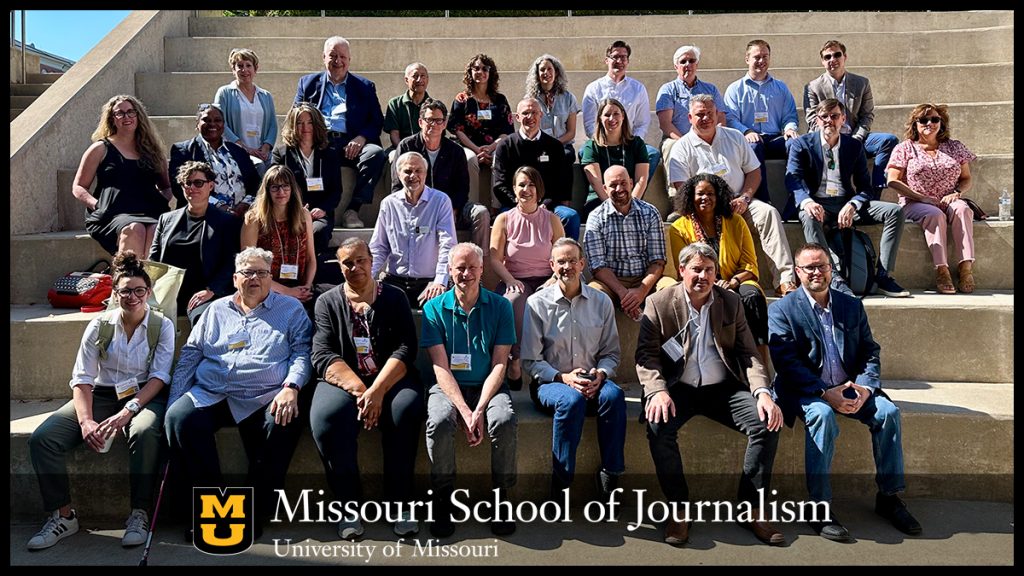Statehouse Reporting Conference brings journalism faculty from all over country to Missouri School of Journalism

COLUMBIA, Mo. (Oct. 30, 2023) — In late September, about 30 journalism faculty from universities around the country gathered at the Missouri School of Journalism’s Reynolds Journalism Institute to share their knowledge and experiences with statehouse reporting. At a time when coverage of state capitols increasingly falls on the shoulders of nonprofit outlets, part-time reporters and students at university-run news services, the faculty came together to share advice on how to build successful statehouse programs.
The conference featured panels moderated by School of Journalism professors and guests from other universities. Participants also toured the collaborative newsroom in Lee Hills Hall where students, staff and faculty from the School’s professional news outlets share resources and information to deliver community news to Columbia.
“The conference allowed for discussion about many of the pressing issues for faculty operating a bureau, including funding, distribution and management of students,” said Elizabeth Stephens, an associate professor and executive editor of the Columbia Missourian. “I think everyone walked away with a concrete idea for improving their program or where to start for a new program.”
For Mark Horvit, a professor and chair of the Journalism Professions faculty group at the School, the conference was the latest step toward a goal he has pursued for several years: a network of university statehouse reporting programs that work together to uncover themes and patterns that are bigger than any one state, giving their audiences access to crucial context.
“I’ve wanted for a while to create something that ties together statehouse bureaus so we can share information and look for things like model legislation,” said Horvit, referring to a draft of legislation that is used as the basis for bills in multiple independent legislatures, often as part of a coordinated effort to introduce similar legislation in state houses across the country. “The people creating this model legislation know what is going on in the big picture, but we don’t. We don’t network the way the people we cover network, and that’s a problem.”
The conference allowed for discussion about many of the pressing issues for faculty operating a bureau, including funding, distribution and management of students. I think everyone walked away with a concrete idea for improving their program or where to start for a new program.
Elizabeth Stephens
Horvit first tried to get such a network off the ground working informally with members of the Institute for Nonprofit News, itself a network of more than 425 nonprofit news organizations. With the help of a team of students, he built a database of recently-passed legislation that would allow users to identify trends and potential story ideas.
The database saw limited use, and ultimately, Horvit realized he was putting the cart before the horse. In the statehouse reporting group — created by Richard Watts, executive director of the Center for Community News (CCN) at the University of Vermont, which provided some funding for faculty to attend — Horvit found other faculty members who wanted to build a nationwide network to share information and ideas.
“The main thing we need is for people to be engaged,” Horvit said.
The establishment of a reporting network is only one goal of the conference, however; overall, the organizers hope that the mixture of participants from experienced statehouse operations and fledgling — or even not-yet-established — programs will help encourage the creation of more new statehouse at universities around the country.
And it’s not just the conference itself that is building a community of collaboration and support among the participating universities; CCN also hosts monthly meetings for the group and offers one-on-one mentorship.
So far, the approach seems to be going over well.
“The conference left me with a plan to move forward and replaced a lot of the stress of trying to create something basically on my own,” said Laura Glasscock, an assistant professor from Kentucky State University. “It really was great for me.”
Horvit and Stephens moderated sessions alongside those from other participating institutions, including the Student Press Law Center. Participants represented 21 different states.
About the Missouri Statehouse Reporting Program
For more than 50 years, students have been covering Missouri politics in Jefferson City. As part of the School’s State Reporting Program, students are not only producing stories for the school’s professional newsrooms — NBC affiliate KOMU-TV 8, community newspaper Columbia Missourian and NPR affiliate KBIA-FM — but also filing them for use across the state through partnerships with the Missouri Press Association (MPA) and Missouri Broadcasters Association (MBA). Some students are also providing content directly to news outlets including KMOX Radio in St. Louis and Learfield Communications.
About the Center for Community News
The University of Vermont’s Community News Service matches student reporters with professional editors to provide critical reporting to trusted sources of local news. CNS functions as both a newsroom and a laboratory for experimentation in creative ways to address the challenges facing local news. The extraordinary potential for growth and demand from other regions inspired the creation of the Center for Community News, an effort to document and meet the urgent needs of other schools around the U.S. that are working to be part of the local news solution.
Updated: October 30, 2023